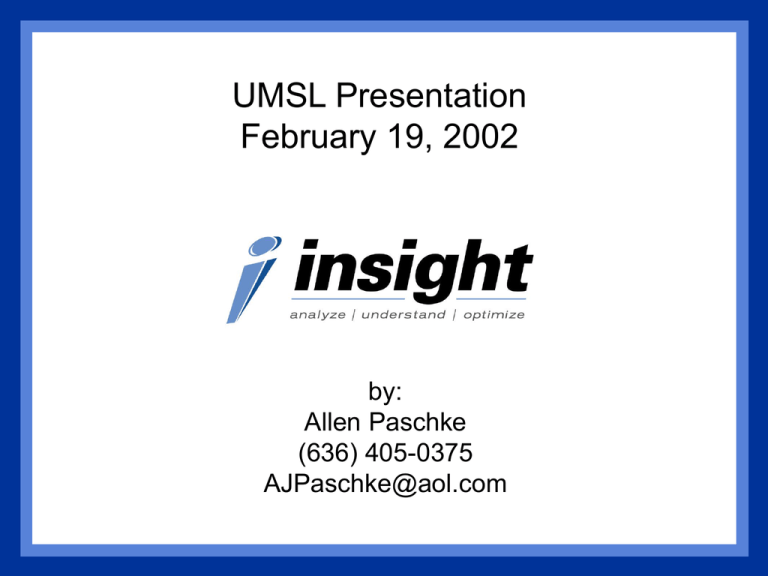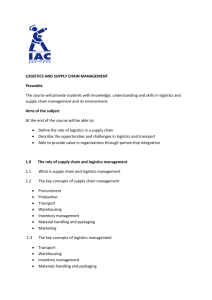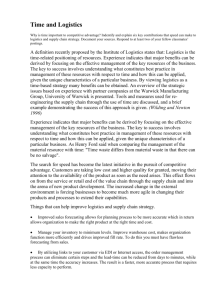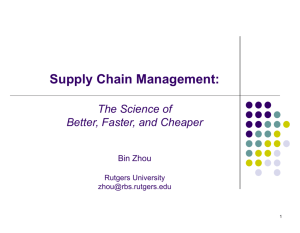Strategic vs. Tactical
advertisement

UMSL Presentation February 19, 2002 by: Allen Paschke (636) 405-0375 AJPaschke@aol.com Integrated Logistics Introduction to Insight INSIGHT – Who We Are > > > INSIGHT Started 1978 Extensive Supply Chain Design Experience Professional Staff • • > Various Honors and Awards • > CLM Distinguished Service Award US Offices • • > 35 employees Average tenure – over 17 years experience Manassas, VA Bend, OR Emphasis on Research and Application Supply Chain Software > Supply Chain Design • > Tactical Modules • • > SAILS Transportation Planning – SHIPCONS II International Trade – GSCM Components • Labor Scheduling, Master Production Planning, Supply Planning, Service Resource Scheduling, Dynamic Sourcing Oil/Chemical/Medical Food & Beverage/CPG Abbott Laboratories BP Amoco Allegiance Healthcare Cytec Bristol-Myers Squibb BASF Pennzoil PPG Industries Ipiranga Exxon Mobil (5 continents) Exxon Mobil Chemical Pfizer Johnson & Johnson Ross Laboratories Monsanto (Flexsys NV) IMC Agrico McKesson HBOC Solutia Manufacturing/Parts Distribution Ferguson Enterprises Toyota Motor Sales Toyota Parts Goodyear Tire & Rubber Co Case New Holland Case Parts Georgia Pacific Sears Ingram Books Purolator Potlatch R.R. Donnelly Toyo Engineering GE Service Parts GE Appliances Technology Compaq IBM Global Services Motorola Ameriserv, Inc. CSI Frito Lay Frito Lay Int’l Colgate Perrier Dr. Pepper - 7Up Procter & Gamble ConAgra Walker Gillette Borden Foods Mars Pepsi-Cola Pepsi-Cola Int’l Pepsi Bottling Ralston Purina Avon Products Nabisco Clorox Unilever Kraft Foods Dean Foods Consultants/3PL’s Accenture KPMG Peat Marwick Frigoscandia Norfolk Southern Pricewaterhouse Coopers Defense Logistics Agency APL CSC Mark VII SABRE Integrated Logistics The Concept CLM Definition 1995 Logistics is the process of planning, implementing,and controlling the efficient, effective flow and storage of goods, services, and related information from point of origin to point of consumption for the purpose of conforming to customer requirements. Integrated Logistics System Design Model Potential Network Schematic Raw Materials Finished Products FW1 CZ1 P1 FW2 CZ2 FW3 CZ3 PW1 P2 S1 PW2 P3 S2 CZ4 FW4 CZ5 PW3 FW5 CZ6 Inbound Replenishment Transfer Outbound Evolution of Thought and Practice • Individual Dispersed Functions Conflicting objectives within the logistics function TRANSPORTATION WAREHOUSING INVENTORY Evolution of Thought and Practice • Individual Dispersed Functions • Integration Within Distribution Conflicting objectives within the firm Manufacturing Logistics Purchasing Evolution of Thought and Practice • Individual Dispersed Functions • Integration Within Distribution • Integration Across Corporate Functions Evolution of Thought and Practice • Individual Dispersed Functions • Integration Within Distribution • Integration Across Corporate Functions • Integration Across Supply Chain, finding win-wins with Suppliers and Customers Network Redesign Business Questions > > > > > > > > > > > How many distribution centers (D.C.s) should we have? Where should the D.C.s be located? Which customers should be served by each D.C.? How do you best balance inventories against customer service needs and distribution costs? Should we contract for warehousing services or operate our own D.C.s? Should pool points be used and where should they be located? What do you gain by plant direct shipping? Should all D.C.s carry all products or should they be specialized by product line? Where should my plants be located? Which product lines should be produced at each plant and how much? Which suppliers should be used? Do you need a Network Redesign? > You would like answers to some of the 11 “business questions” > You have never redesigned your network(s) or it has been many years since the last redesign was completed > Multiple divisions exist within the parent company and you are not leveraging Warehousing and/or Transportation. > You are acquiring a company Integrated Logistics Process to Redesign Supply Chains Introduction > Redesigning a Supply Chain is a PROCESS > The SAILS software is a TOOL used in this process > When you’re redesigning a Supply Chain, a good process is beneficial. > This is the process that I’ve used many times, with good results, to redesign Supply Chains. The Process > Establish Project Management > Define Objectives and Scope > Design Model > Data Collection > Model Validation > Optimization > “What If” and Sensitivity Analysis > Recommendation > Implementation > Post-Implementation Review Project Management > Establish Project Sponsor • > Best experiences with CFO or CEO Why has the project been initiated? • What is the “compelling event”? • What needs improving? - Too much Inventory - Customer Service lead times need tightened - Logistics Costs too high Project Management > Executive ("Steering") Committee required? • • Establish cross-functional team (MIS, Logistics, Sales, Manufacturing, Customer Service, Purchasing, R&D, Finance, etc.), usually VP or Director level: - Break down organization "silos" - Create a better solution - Improve the probability that the solution will be accepted by the entire organization Meet every 6 - 8 weeks Project Management > > > Establish full-time Project Manager Establish Working Committee • Establish team, usually Manager level, with "hands on" responsibility to spend 25 to 50 percent working on this project • Meet "formally" every 2 - 3 weeks Utilize Steering Committee to create “Task Forces”: • Customer Service • Product Compatibility and R&D Requirements (temperature, etc.) • Inventory Carrying Cost Methodology • Accounting Issues, such as Fixed vs. Variable Warehousing Costs Objectives and Scope > Objectives (and Goals) • • • • > Why has the project been initiated? (What needs improving)? What business question(s) do you need answered? Define as many "What If" and Sensitivity Analysis questions to be answered, as possible STAY STRATEGIC Scope • • • • • Which Business Units included? Due to product incompatibilities, do multiple Supply Chains need to be designed? How many? Outbound (and Inbound(?))? U.S. (and Canada(?) and Mexico(?))? Include/exclude import/export (port)? Model Design > To design the model correctly, the objectives, the scope, and as many "What If" and Sensitivity Analysis questions, as possible, should be defined. Failure to do this, will increase the risk that the model will not be designed correctly, requiring extensive efforts to redesign the model later in the project. > First step, sketch the current flows of the existing supply chain(s), defining all the “links”. Discuss what future flows should be allowed > How many supply chains need to be designed? Sketch them. Model Design > > For each supply chain (model): • How many echelons? • Current and candidate D.C.s, cross-docks, etc. • How do you ship products (Small Package, LTL, TL, Pool, Pick-up, Rail, etc.) • D.C., cross-dock, etc. missions • Customer Service guidelines, current, proposed and “what if” • Etc., etc. Roles and responsibilities of each member of the Working Committee. Assign tasks and due dates. Data Collection > > Collect: • Network Description - Locations (Customers, D.C.s, Plants, Suppliers) • Transportation Costs - Inbound, Replenishment, Transfer, Outbound • Demand Data - Every Line Item from Every Order for a year • Facility Data (Suppliers, Plant and D.C.) - Fixed & Variable Costs - Capacities • Eligibility - D.C.s - Product Master with Production Source(s) Identified - Suppliers VERIFY all data to ensure that it is valid Model Validation > First, replicate flows (volumes) • > MY GOAL --- 99.75+% accurate Second, replicate costs. (This is an iterative process, until the variance between actual and the model reach an acceptable level). • MY GOAL: - - Nationally, within 1 to 2 percent of “unexplained” variance. By facility, within 5 percent of “unexplained” variance. Model Validation > (If the “unexplained” variance is at the 5 - 10 percent range, no confidence exists when an optimization run shows a 10 percent cost reduction. It is not until the “unexplained” variance is in the 1 to 2 percent range that an optimization run showing a 10 percent cost reduction can be believed). > Develop spreadsheet, starting with the model (validation) costs, adjusting for known (“explained”) variances, and comparing to actual costs Model Validation > “Explained” Variances (examples): • Transportation Costs - Returns/Product Recall - Damaged - Accessorial (Fuel, Delay, Lumpers, etc.) - Expedited Transportation - Accounting Anomalies • Warehousing Costs - Different Inventory Turns - Overflow Warehousing - Accessorial (Special Services, extra shifts, overtime, etc). - Accounting Anomalies • Plant Costs Optimization > Optimize the Supply Chain, meeting the customer service Requirements. (This should occur very quickly, a majority of the analysis should be "What If" and Sensitivity analysis). “What If” and Sensitivity Analysis > Most common Analysis: • Sensitivity Analysis: - Distribution cost vs. number of D.C.s Distribution cost vs. Customer Service – Cost for improved service – As service is improved, are current D.C.s still being utilized “What If” and Sensitivity Analysis > Most Common Analysis (continued) • “What If” Analysis: - Impact of inflation (D.C. vs transportation costs) - Growth Analysis (can handle forecasted growth) Impact of plant capacity expansion (new plants) Impact of new product introduction - Which plant – 1 vs. 2 plants D.C. capacity expansion - – - - Alternative echelon networks – Plant direct – Cross-Docks / UPS Zone Skipping Implementation priority analysis Recommendation > A recommendation should be made, including: • Supply Chain ("flow" and costs), AS IS • Supply Chain ("flow" and costs), TO BE • Expected benefits • What was analyzed but didn't produce benefits • Implementation plan, including • Priorities - Technology Organizational impact - Implementation > Additional time should be planned for further "What If" and Sensitivity Analysis to assist the implementation team. (For example, the model recommends a D.C. in Omaha. The implementation team can not find the space in Omaha at a reasonable price. What is the additional transportation cost if the D.C. were in Kansas City or Des Moines)? > Now is the time to support the implementation with tactical analysis. Post-Implementation Review > I’m a strong believer that 6 to 12 months after the implementation, the project should be evaluated and the actual benefits quantified. > Most of my recommendations have reduced the number of D.C.s, so more volume was going through fewer locations. Due to increased leverage (transportation and warehousing), the actual benefits usually exceed what the software predicted. • • All projects 5 to 15 percent Logistics savings Majority in 8 to 12 percent range Integrated Logistics The Optimizer Too often users don’t ask enough questions about what the solver does and how. They seem to assume that if a program can make pretty pictures, it must also be able to get good answers. In short, THEY BUY THE PICTURES, NOT THE SOLUTIONS! SAMPLE PROBLEM DC1 PLANT 1 Capacity: CZ2 100,000 CZ3 50,000 3 5 4 DC2 4 2 Capacity: 60,000 50,000 3 0 PLANT 2 CZ1 2 0 1 HEURISTIC SOLUTION 1 “LEAST OUTBOUND COST” DC1 PLANT 1 CZ1 50,000 CZ2 100,000 CZ3 50,000 3 0 3 140,000 PLANT 2 5 4 DC2 4 2 2 0 60,000 1 Inbound cost Outbound cost Total $820,000 $150,000 $970,000 HEURISTIC SOLUTION 2 “LEAST TOTAL FLOW COST” DC1 PLANT 1 50,000 CZ2 100,000 CZ3 50,000 3 0 3 50,000 5 PLANT 2 CZ1 4 DC2 90,000 4 2 2 0 60,000 1 Inbound cost Outbound cost Total $570,000 $200,000 $770,000 The key to good analysis is the range and quality of alternatives generated for evaluation. Solver Technology: Heuristics Characteristics • common sense consideration of limited alternatives • not guaranteed to find best solution • solution dependent upon quality of decision rules • run-to-run comparisons unreliable Applications – crew scheduling – vehicle routing – shipment planning Solver Technology: Simulation Characteristics • imitates sequence of events/conditions over time • no attempt to find best solution • limited to process evaluation • difficult to validate • expensive to develop, maintain, and run • run-to-run comparisons very difficult Applications – queuing problems – inventory control – plant/DC operations OPTIMIZATION generates and considers all alternatives in a given scenario -with heuristics and expert systems alone, many alternatives are never envisioned, much less evaluated! Solver Technology: Optimization Characteristics • evaluates all possible alternatives • guaranteed to find best solution • run-to-run comparisons reliable • not widely available Applications – network design – production planning – cash flow planning SOLVER TECHNOLOGY *SAILS is TRUE OPTIMIZATION USING MIXED INTEGER LINEAR PROGRAMMING (*RESEARCH PUBLISHED IN REFEREED ACADEMIC JOURNALS) OPTIMAL SOLUTION “TRUE LEAST COST” DC1 PLANT 1 CZ1 3 0 3 140,000 5 PLANT 2 40,000 4 DC2 4 50,000 2 CZ2 2 100,000 60,000 0 60,000 1 Inbound cost Outbound cost Total $120,000 $470,000 $590,000 CZ3 50,000 Good models are like bright lights focused on dark corners. Conventional wisdom is frequently wrong -- Management Science has shown this time and time again. Integrated Logistics SAILS Model Multiple Stages of Manufacture STAGE 1 STAGE 2 Line 1 Line 1 Raw materials Line 2 Line 2 Finished in Line 3 Line 3 products out Raw materials Intermediate products Finished products Important Model Features Multiple stages of manufacture (conversions) Multiple processing lines per stage N-echelons of distribution centers Multiple cost functions per facility Sole source option Facility status: fix/float options Multi-Time Periods PRODUCT AGGREGATION Stock Codes Product Groups TR 968-14 TR 472-10 TR 784-16 1. Tires TR 968-14 TR 472-10 TR 784-16 EL 497-23 2. Electronics TR 968-14 TR 472-10 TR 784-16 CQ 491-79 3. Mechanical DEMAND DATA: TARGET Customer zones 1 2 3 4 5 . . . L Product Groups 1 2 3 4 X 5.......I Annual demand TRANSPORTATION DATA: TARGET Origins 1 2 3 4 5 . . . M Destinations 1 2 3 X 4 5.......N Average cost/cwt GEOGRAPHIC AGGREGATION 1-DIGIT ZIP ZONE 5 0 9 8 6 7 1 4 2 3 TRADITIONAL CAPACITY LIMITS Capacity Limit UNIT VARIABLE COST VOLUME “ELASTIC” CAPACITY LIMITS Capacity Limit UNIT VARIABLE COST } Penalty VOLUME Integrated Logistics Case Study ADF, Inc. > > > > > > > > > Manufacturer of consumer goods Founded in 1927 Sales in 1980: $460mil 12 major categories of product 2 production technologies 11,000 customers 100,000 orders per year 98% fill rate with 7 day order cycle 5 plants and 17 distribution centers Historical Situation - 1930 Plant Distribution center Market area $ Transportation to Customers ADF DISTRIBUTION COST RELATIONSHIPS 1930 (est.) Transportation to Warehouse Warehousing Inventory Carrying Costs HISTORICAL SITUATION - 1940 P1 Plant Distribution center Market area P1 HISTORICAL SITUATION - 1950 P1, P2 Plant Distribution center Market area P1 P2 HISTORICAL SITUATION - 1960 P1, P2 Plant Distribution center Market area Local overflow warehouse P1 P2 HISTORICAL SITUATION - 1970 P1, P2 P2 Plant Distribution center Market area P1 P2 P1 AT TIME OF STUDY P1, P2 P1 P2 P1 P2 Plant Distribution center Market area CURRENT ADF DISTRIBUTION COSTS $ Transportation to Customers Transportation to Warehouse Inventory Carrying Costs Warehousing PD/Percent of COGS 10 8 _ 11.4% Actual 8.2% _ 6.5% 4 _ DISTRIBUTION COSTS GROWING FASTER THAN MANUFACTURING COSTS _ _ 2 _ 1960 1970 _ 6 study DISTRIBUTION COSTS GROWING FASTER THAN SALES $463 MM P.D. Costs Percent of Sales 1970 - 5.8% study - 8.0% Distribution Sales $138 MM $8 MM 1970 $37 MM study INVENTORY TURNOVER DECLINING Finished Goods Inventory Cost of Goods Sold $324 MM Inventory Turns 1970 - 7.5 study - 6.0 $97 MM $54 MM $13 MM 1970 study MANAGEMENT’S RESPONSES HAVE BEEN INCREMENTAL AND SUBOPTIMAL Impact on functional area Manufacturing costs Arbitrary inventory cuts Additional warehouses Mode mix changes Plant warehouse space usurped Transportation costs Warehousing costs Inventory costs Customer service/sales MANAGEMENT OBJECTIVE Fundamental question asked by management . . . What production-distribution network will yield greatest return on assets, given all trade-offs in the system? Specific Issues > What are the appropriate customer service goals to pursue? > How should inventory be stratified and positioned in the various levels of the production - distribution system? > How many distribution centers should there be, where should they be, and what service areas should be assigned to each? > Should new plant locations be opened and should the production mix among plants be changed? > Which plants should provide which products to each warehouse and what mix of transportation modes should be used? RECONFIGURED SYSTEM P1, P2 P1 P2 P1 P1, P2 P2 Plant Dist. center Change in: Plants Distribution Centers 5 17 6 9 Distribution Center Replenishment Flows 22 6 Financial Results > Actual • Reduction in Distribution Costs of 20% - • > Fewer DCs Less Plant to DC freight Less inventory Increase in ROA of 8% over an already favorable 12.5% Expected • • • Improvement in customer service/satisfaction More streamlined network Improved inventory deployment Outcome of Specific Contingency Analyses If • TL increases disproportionately vs. LTL Then • West Coast plant more advantageous • LTL increases disproportionately vs. TL • 3 more warehouses feasible • Service level (order cycle time) relaxed • 1 less warehouse feasible • Unit production cost estimates at new plant low by >10% • Logistics benefits of new plant negated • Cost of money under 10% • 4 additional warehouses feasible Network Evaluation Process Manufacturing technology Raw material availability Corporate policies/ strategies Service goals Marketing goals Future transportation costs Financial goals Plan & Launch Project Generate Baseline Optimization of existing network Alternate scenario definition Alternate scenario optimization analysis Management Analysis Integrated Logistics Summary





